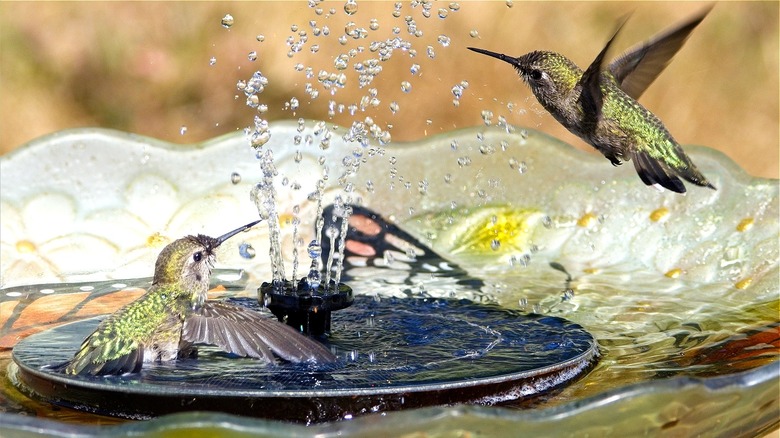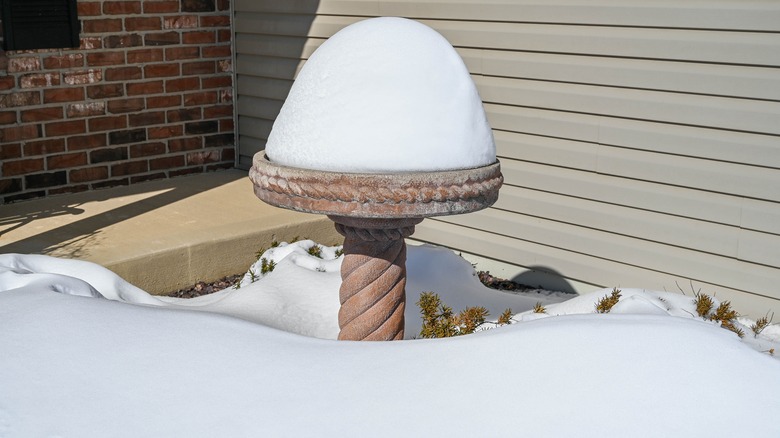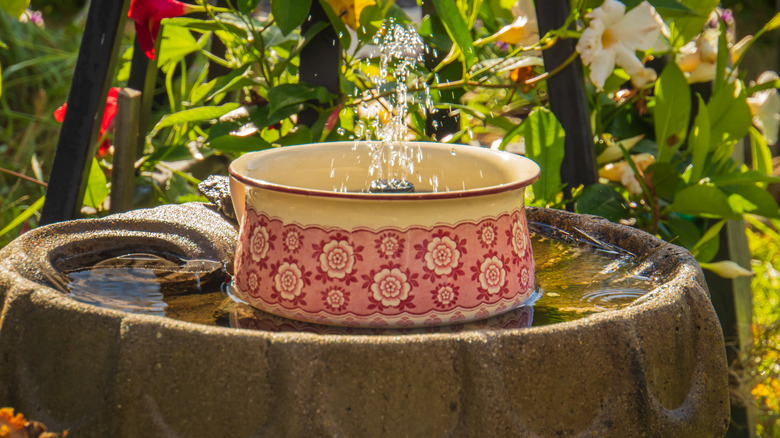The Drawbacks Of Putting A Fountain In Your Birdbath
Adding a fountain to a birdbath can certainly seem like a good idea. For one, the water display may help to attract even more birds to your yard, and all birds will benefit from having a healthy water source. Further, the constant motion of a working fountain can create a nice aesthetic for your outdoor space, and the sound of moving water can prove a relaxing experience. This said, despite these benefits, there are drawbacks to consider if you're thinking of putting a fountain in your birdbath — namely, maintenance and cost.
Birdbaths with fountains typically cost more than standard birdbaths without the feature. They also require more maintenance (an added cost), and it should be noted a fountain's pump won't work properly if temperatures drop too low. The most important aspect of a birdbath, though, is that it provides fresh, clean water for visiting birds. While a fountain is impressive and there are certainly benefits to having one, it's important to weigh the potential drawbacks of adding one, too, to ensure you make the right choice for your yard and your birds.
Why fountains in birdbaths aren't always ideal
Fountains can be stand-alone features in your backyard that just happen to serve as a birdbath, or you can choose a birdbath with a moving-water feature. No matter what you purchase, buying a fountain is going to be more expensive than just a birdbath. Those added costs come from the materials themselves, which involve a working pump, which can be either solar-powered or electric. If electric, that means you'll also be paying for electricity to keep it operational, as well as figuring out a setup that allows you to run a cord to it without having to worry about running over it with the lawnmower.
The key to remember, too, is that these pumps require careful management and could fail without it, requiring replacement. That maintenance itself may prove a drawback for some. Further, you may need to remove and bring the fountain component into your home during winter when it freezes to prevent water from freezing within the pump and damaging it. During the use season, the mechanism will need to be removed, cleaned, and sanitized routinely to prevent algae growth and mold buildup.
Another less obvious drawback to putting a fountain in a birdbath is evaporation. The pump's movement of water will cause evaporation more readily than just a standing container of water. That means you'll need to monitor and fill it in a timely manner. You don't want the pump to run dry as that can cause significant damage and possibly pump replacement.
If you still want a fountain, consider these tips
The allure of running water is simply too good to pass up for some. For that reason, if you decide to add a fountain to your birdbath or purchase a new birdbath with a fountain, consider a few tips that will address the potential drawbacks of having such a feature in your yard.
First, keep the birdbath closer to the home, such as in a flowerbed, so you don't have to run cords to it. Alternatively, you could go with a battery and solar-powered birdbath that eliminates the need for electricity altogether. Next, consider the fountain's design and choose one that will be easy to maintain. Also, be sure to create a routine (and schedule) for cleaning the pump regularly. You may be able to add algae preventatives to the fountain, but don't do this if it puts the birds at risk (read any product label carefully).
In the offseason, consider bringing in the entire birdbath and storing it in the garage or a heated shed. Depending on the materials of the bath itself, it may not be ideal for freezing temperatures anyway. You can also purchase a pump and construct your own DIY birdbath out of plastic, composite, or cement containers in your home. That's going to drastically reduce the overall cost (a budget drawback) of your new bird attraction. Repurpose items in your home to help with this creation, like an old watering can, a discarded cast iron pot, or a terra cotta planter you no longer use.


